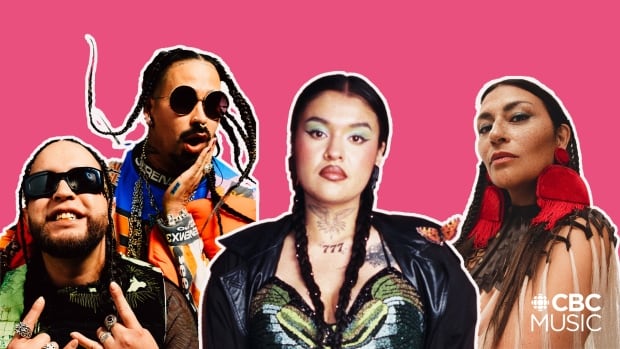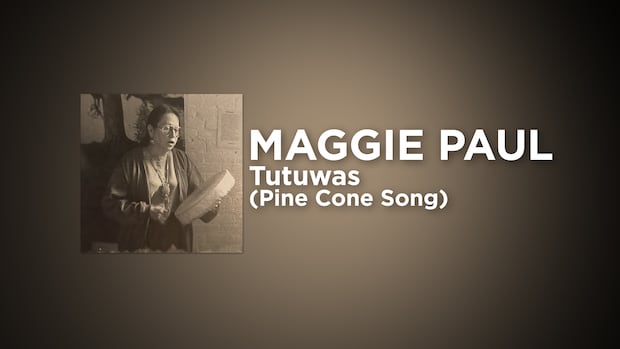
National Indigenous People’s Day, also known as June 21, has existed for nearly three decades as a day to celebrate First Nations, Inuit and Métis joy, history, art and culture across Turtle Island. It’s also the summer solstice, a time of new life and season marked on the longest day of the year.
To celebrate this day and give thanks to those who came before, CBC Music asked Indigenous musicians to talk about who has made a difference to them as artists, and why — and what song they think is a must-hear from the artist they’re celebrating. The result is a beautiful recognition of both industry veterans and contemporaries — plus a perfect playlist to mark the day.
Reclaimed53:22Summer Solstice Mix 2024
Artist: Jeremy Dutcher
Artist to celebrate: Maggie Paul
“I was always taught to acknowledge those who have gone before us and helped clear our path, and there is no greater path-clearing, space-making influence than Maggie Paul on how or why I make music. Wisoki-woliwon nutakehkikemit ciw lintuwakonol naka psiw-te kehkituwakonol!
“Nulasweltom naka koselomol.”
Must-hear song: “tutuwas (pinecone song)”
Elder Maggie Paul sings a traditional waponahkiyik (people of the dawn) dance song
“Recorded on a single ambient microphone in the late ’80s, this recording of a traditional waponahkiyik (people of the dawn) dance song stands as a favourite in my collection. ‘Tutuwas (pinecone song)’ is a song often heard when we gather at powwows or community events, where pine needles are placed on the drum skin and the young women are invited to come dance. As they dance around, the goal is to closely follow the instructions given by the singer’s lyrics. ‘Dance forward, dance back, dance sideways, dance proud’: think of it like the Indigenous ‘cha-cha slide’ — a real banger.
“As a kid I heard this song sung most often by Maggie Paul, so when I hear this recording, it sounds like home. I am transported.
“Maggie’s way of using her voice and catalogue of songs have had a profound impact on my own musical journey and expression. This song’s beauty rests in its simplicity of line as much as in its use of the voice unbridled, ringing out atop the steady acceleration of her drum; a masterclass in traditional waponahki dance song form. Compounding this beauty is to comprehend that you are hearing a critically endangered Indigenous language sung by a fluent lifelong speaker; I am so grateful this recording exists.”
Artist: Tia Wood
Artist to celebrate: Fawn Wood
“I would say my sister Fawn, because she was really, truly a trailblazer growing up…. She won a lot of big singing competitions. And she was the first woman to do a lot of things. She won some of the biggest contests in the world for traditional singing, and she was the first woman to win her category [traditional Indigenous artist of the year] at the Junos. It has to be her, because growing up, she really showed me so much support and so much motivation.”
Must-hear song: “A Song for Mosom”
“That song came to her in such a crazy way actually. Somebody came up to her at an event and showed her this song, and they said, ‘My Mosom,’ which means grandfather, ‘My grandfather would always sing this song.’ And we just grew up in such a musical family, so it was really special receiving that and just [Fawn’s] rendition of it. Whenever I hear that song, it just really makes me think of home because [there’s] a guitar in it, it sounds kind of country, and that’s kind of what our radios out in the rez could reach was only country music radio. So that song really represents home for me.”
Artist: Elisapie
Artist to celebrate: Sugluk
“I think I’m going to go with Sugluk, my uncle’s band. I mean, I’m from a small town, so when you’re from a small town, you usually have your local singer-songwriter. Kind of like you’re just playing music, you know? But these guys have been playing music since the ’60s. Since Churchill, Manitoba, residential school. It’s funny because, all the people that I love, too, were making music: Willie Thrasher, Willie Dunn — maybe not so much Willie Dunn, but William Tagoona…. a lot of boys, and not many girls in there. Sugluk band, Charlie Adams, all the great singer-songwriters I know, they all formed a band in Churchill, Manitoba, where they were residential school teenagers.
“So my uncle’s band have been making music and rock ‘n’ roll since the ’60s. So when I was growing up in the ’80s, I just felt like I had these pros, I had these real singer-songwriters to look up to, especially my uncle. He’s such a great singer. And back then he was doing more rock ‘n’ roll so his voice was a little bit more on the rock ‘n’ roll side, but now he’s still singing. He’s what, I’d say early 70s now? But he’s not a singer — he just, I don’t know how to say it, he’s beyond [being a] singer. He has that gift of melody, emotion. And he’s a great one. So I was able to really say, ‘Well, I can do it. I have it in me because I have my blood’ [laughs]. It’s the same thing. It’s a family affair and it’s such a big pride in my town, that family…. We’re very connected musically.”
Must-hear song: “Ajuinnarasuarsunga”
“‘Ajuinnarasuarsunga’ is really beautiful because it’s a ballad. It’s a love song about this boy who was just feeling hopeless. To hear an Inuk boy who is, you know, pretty much saying, ‘I really want to be with you, I think I’m the one for you, but you’re somewhere else. So you have your own path, you’re with them.’ And it’s so true [laughs]. It’s so true. It’s almost like a country song in a way. You know how country songs can be just so honest? Well, there’s so much honesty in that song.”
Artist: Asko
Artist to celebrate: Joe Rainey
“Joe Show challenges the status quo by being entirely himself. He caters to no one, and I don’t think he cares what anyone thinks. What courage, what passion. Joe, like me, is an urban Indigenous person. As a kid growing up in Minneapolis, he started going to powwows with his little tape recorder, documenting the sounds of drummers, singers and callers. His mom signed him up to learn to sing powwow at a local urban Indigenous organization. He got better and was brought into a renowned touring powwow group, learning, caring and sharing songs. At some point, he carried all those teachings and moved into contemporary music. His lauded debut, Niineta, was all it took for me to grasp something I’d never heard before. For me, it was immediate. His process of making something considered old, challenging the status quo, demanded I start believing in my work and walking with pride. Joe Rainey is my game-changer.”
Must-hear song: “b.e. son”
“Joe’s music is quite emotional. He challenges us to like it or not. I think ‘b.e. son’ is a good place to start. If you like what you hear, I recommend listening to the entire album on headphones while walking the dogs. Hopefully, Joe inspires you to go walk a little farther, climb a little higher, and lean into the emotion of a beautiful artist.”
Artist: Snotty Nose Rez Kids
Artist to celebrate: The Halluci Nation
Quinton “Yung Trybez” Nyce: I would say that the artists that made the biggest impact was probably Halluci Nation, just because we followed them for so many years and [we’d] seen them in the same spotlight that we are in. And, you know, we kind of followed their journey. And what they had to say about their journey is what really inspired us to continue on with ours.
And one thing that they did talk about is the importance of creating safe space for Indigenous people to be able to turn up, you know? Because before, when I first moved to the city, it was kind of like them breaking onto the scene, there wasn’t really a scene for Native people. And Tribe Called Red really created something for us to be able to, you know, come and unwind on a Friday, Saturday night at A Tribe Called Red show. And that’s what we were inspired to be, we were inspired to be a safe place for Native people to come out and just do the same thing that they did at Tribe Called Red shows.
Must-hear song: “R.E.D.” and “Stadium Pow Wow“
Darren “Young D” Metz: That was the one that really took off. And yeah, there’s another version where they have Yasiin Bey on [“R.E.D.”] and it’s just so fire. That was the first time [we’d] seen an Indigenous artist link up with a legend —
Yung Trybez: A legendary rapper. Legendary rappers.
Young D: That was inspiring for sure.
Artist: Sebastian Gaskin
Artist to celebrate: Derek Miller
“Derek Miller was one that was a big part of my childhood growing up. I believe he’s Mohawk, from here in Ontario. He’s a rock ‘n’ roll guitarist. My aunties grew up listening to him a lot. So he was always on around the house, during the daytime when they were cleaning up, that kind of stuff. So, yeah, he’s a really, really great guitarist.”
Must-hear song: “Stormy Eyes”
“That’s a song that I tie very heavily to my formative years a little bit. I grew up in Manitoba, so whenever my mom and auntie would go down on trips to Winnipeg from up north, they’d always play Derek Miller. I have lots of good memories of sitting in the backseat, you know, hanging my head out the window.
“Over the past four months or so, I’ve kind of gotten more in touch with my guitar playing, which has been really liberating because I feel like I hit a bit of a plateau, and I’ve kind of gone back to songs I listened to back in my childhood and kind of reignited that spark.”
